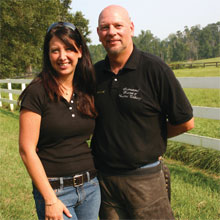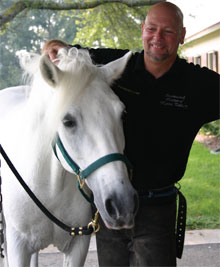

Story & Photos by Cynthia McFarland
You could say KC La Pierre has a “thing” for feet. Make that horse feet. He has literally dedicated his life to understanding the equine foot. Today, Keith “KC” La Pierre is considered one of the foremost equine podiatrists in the world, and his lecture presentations and workshops take him across the United States and overseas throughout the year.
He refers to his new science of “whole-health hoof care” as Applied Equine Podiatry, which is all about getting the best foot possible under the horse. Together with his wife, Robyn Lord, KC founded the International Institute of Equine Podiatry, Inc. in 2003. The La Pierres relocated from Delaware to the warmth and sunshine of Ocala in 2005. Their mission is to educate horse owners, farriers, and veterinarians.
In its natural wild state, the horse survived for many, many years without the aid of shoes. Yet, once man domesticated this noble animal, he decided the hoof needed protecting. Those earliest of “shoes” were likely fashioned from leather hides and tied on. Eventually, man realized he could nail an iron shoe to the horse’s hoof.
Through the centuries, blacksmiths have fashioned shoes to help correct and deal with a wide variety of problems.
“The right shoe can take a lame horse and make him useable, but not sound,” KC points out. “Down the road, the horse starts to develop other issues.”
Horses and horseshoes. The two go hand in hand — or do they? In KC’s opinion, the answer is a resounding no. In fact, he strongly believes that horses are usually always better off going shoeless.
Interestingly enough, he didn’t always feel this way. Beginning in the early 1980s, KC made a good living as a farrier, shoeing and trimming horses for two decades. It wasn’t until he began doing his own in-depth research that he began to have doubts about the fundamental science behind many of the commonly accepted practices in his career.
To understand KC’s passion for what he does today, it is necessary to backtrack a bit. In the mid-1990s, he had the opportunity to work as an assistant to Paul Spaulding, a master blacksmith at the Farmers’ Museum in Cooperstown, New York. Eager to improve his iron-working and horseshoe-making skills, KC jumped at the chance and worked with Spaulding for two years to become a journeyman blacksmith.
It was during this time that KC began seriously studying the equine foot, poring over research papers and dissecting hundreds of cadaver feet. This research, combined with his continuing blacksmith work, caused him to start looking at shoeing and the horse’s foot in a totally different light. He began to realize that nailing a shoe on the foot didn’t support the theories he was developing about how the foot should optimally function.
Nature designed the horse’s hoof as a shock absorber, yet when a shoe is nailed to the foot, it actually prevents the hoof from flexing under impact and interferes with the hoof’s natural ability to absorb shock. KC’s theories also focus on utilizing the horse’s energy or momentum without wasting it, which he believes takes place when the shoe absorbs the horse’s energy at the moment of impact.
“The hoof is a hoof is a hoof, whether it belongs to a wild horse or a domestic horse,” observes KC. “The foal is born with a foot that is very adaptable. Farrier work, nutrition, terrain, exercise, and a host of other environmental influences are responsible for the development of the foal’s foot. In the wild, the feral horse gives birth to its foal and immediately the foal is asked to move. Compare this to the domestic birth, where the foal is born in a foaling stall. The foal gets to its feet and it feeds.”
As he explains, environment plays a major role in hoof care and unfortunately, domestication has not — as a rule — been helpful in this area. Horses are stabled much of the time, or are turned out on lush, moist pasture and do not regularly travel over abrasive surfaces that will naturally wear down the hoof. The horse has the innate ability to heal itself, KC notes, but the proper environment is vital.
In his presentations and workshops, or when called to consult on a specific horse, KC teaches the horse owner how to compensate for the environment they have to give the horse’s foot the best opportunity for healthy growth.
“We can only help the horse,” he adds, “if the owner is willing to take responsibility of getting involved and getting educated about the horse.”
Exercise, nutrition, environment, and knowledge all play a part.
Tradition carries a lot of weight in the horse business and people are often hesitant to try something different until they feel there is no other option. KC admits that it has taken some time to overcome this “last resort” image, but he’s heartened to find this is changing and he applauds the efforts of owners seeking a more natural approach to horse care.
In the United States and beyond, the “natural horsemanship” movement has grown tremendously over the past decade. Many horse owners are dedicated to handling their horses in a “no force, no fear” manner, and are also investigating more natural ways of caring for their equine charges. The growing acceptance of such therapies as acupuncture, chiropractic, herbal, and homeopathic medicine is proof of this expanding awareness.
“We now find that more concerned and insightful horse people are seeking out our information on proper hoof care,” he notes. “The natural horsemanship movement has caused people to change the way they view hoof care. It is never too late to implement sound reasoning. What we need to keep in mind is the horse’s welfare.”
Well-spoken and articulate, KC is as comfortable lecturing to an audience of veterinarians as he is underneath a horse, trimming its feet. Travel keeps KC and Robyn on the road nearly three weeks out of every month, averaging six to eight expos per year and two to three workshops each month.
KC also lectures to many farriers and veterinarians and is encouraged to find they are typically very open to his theories. This is particularly apparent in the United Kingdom.
“In England, our classes are full six months in advance,” says KC, who has lectured to vet students at Cambridge University and worked with London’s Metropolitan Police horses.
Spend just an hour with KC and Robyn La Pierre and there’s no doubt they have a burning passion for helping horses and educating horse people.
“Everything with horses is not in a textbook because the variables are so different,” offers Robyn. “With most horses, there’s usually more than one right answer. You have to choose the one that gets the best answer, the quickest.”
Institute of Equine Podiatry, Inc.
KC and Robyn La Pierre
equinepodiatry.net
(410) 937-6610.






